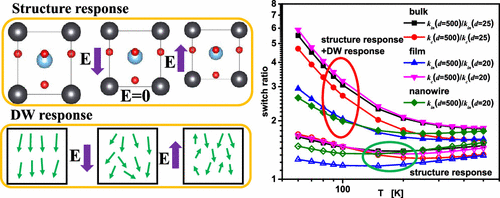当前位置:
X-MOL 学术
›
J. Phys. Chem. C
›
论文详情
Our official English website, www.x-mol.net, welcomes your
feedback! (Note: you will need to create a separate account there.)
Bidirectional Tuning of Thermal Conductivity in Ferroelectric Materials Using E-Controlled Hysteresis Characteristic Property
The Journal of Physical Chemistry C ( IF 3.3 ) Pub Date : 2020-11-18 , DOI: 10.1021/acs.jpcc.0c08471 Chenhan Liu 1 , Ping Lu 1 , ZhongZhu Gu 1 , Juekuan Yang 2 , Yunfei Chen 2
The Journal of Physical Chemistry C ( IF 3.3 ) Pub Date : 2020-11-18 , DOI: 10.1021/acs.jpcc.0c08471 Chenhan Liu 1 , Ping Lu 1 , ZhongZhu Gu 1 , Juekuan Yang 2 , Yunfei Chen 2
Affiliation

|
Unlike the wide range control of electrical conductivity, the tuning of thermal conductivity is difficult especially for the increase or bidirectional tuning. Traditional methods typically only decrease the thermal conductivity by increasing the phonon scattering. In this work, through first-principles calculations, the E-field-controlled hysteresis characteristic of ferroelectric materials is utilized to realize the bidirectional tuning of thermal conductivity. Under the electric field, the structure, i.e., the lattice constants and atomic coordinates, has an opposite response depending on the direction of the E-field, leading to the opposite change of thermal conductivity. Moreover, the electric field can also induce the domain wall response, i.e., the change of domain size or domain wall density, which can be combined with structure response to increase the range of bidirectional tuning. The tuning range for structure response has a weak dependence on temperature, while for domain wall response, it increases significantly with decreasing temperature since phonon transport at low temperature is sensitive to the domain wall scattering. The dimensionality effects (bulk, thin films, and nanowires) on the tuning range are also investigated. The calculation results show that bulk PTO and cross-plane direction of PTO thin film have a larger tuning range, while the in-plane directions of thin film and nanowire have a smaller value. The results in this work give a new guideline to search for bidirectional tuning of thermal conductivity.
中文翻译:

利用电子控制迟滞特性特性双向调整铁电材料的导热系数
与电导率的大范围控制不同,导热率的调整非常困难,尤其是对于增加或双向调整而言。传统方法通常仅通过增加声子散射来降低热导率。在这项工作中,通过第一原理计算,È铁电材料的-field控制滞后特性被利用来实现热导率的双向调谐。在电场作用下,根据E的方向,结构(即晶格常数和原子坐标)具有相反的响应场,导致相反的热导率变化。此外,电场还可以引起畴壁响应,即,畴尺寸或畴壁密度的变化,其可以与结构响应结合以增加双向调谐的范围。结构响应的调谐范围对温度的依赖性较弱,而对于畴壁响应,调谐范围随温度降低而显着增加,因为低温下的声子传输对畴壁散射敏感。还研究了尺寸范围(体积,薄膜和纳米线)对调谐范围的影响。计算结果表明,体PTO和PTO薄膜的横截面方向具有较大的调谐范围,而薄膜和纳米线的面内方向具有较小的值。
更新日期:2020-12-03
中文翻译:

利用电子控制迟滞特性特性双向调整铁电材料的导热系数
与电导率的大范围控制不同,导热率的调整非常困难,尤其是对于增加或双向调整而言。传统方法通常仅通过增加声子散射来降低热导率。在这项工作中,通过第一原理计算,È铁电材料的-field控制滞后特性被利用来实现热导率的双向调谐。在电场作用下,根据E的方向,结构(即晶格常数和原子坐标)具有相反的响应场,导致相反的热导率变化。此外,电场还可以引起畴壁响应,即,畴尺寸或畴壁密度的变化,其可以与结构响应结合以增加双向调谐的范围。结构响应的调谐范围对温度的依赖性较弱,而对于畴壁响应,调谐范围随温度降低而显着增加,因为低温下的声子传输对畴壁散射敏感。还研究了尺寸范围(体积,薄膜和纳米线)对调谐范围的影响。计算结果表明,体PTO和PTO薄膜的横截面方向具有较大的调谐范围,而薄膜和纳米线的面内方向具有较小的值。











































 京公网安备 11010802027423号
京公网安备 11010802027423号